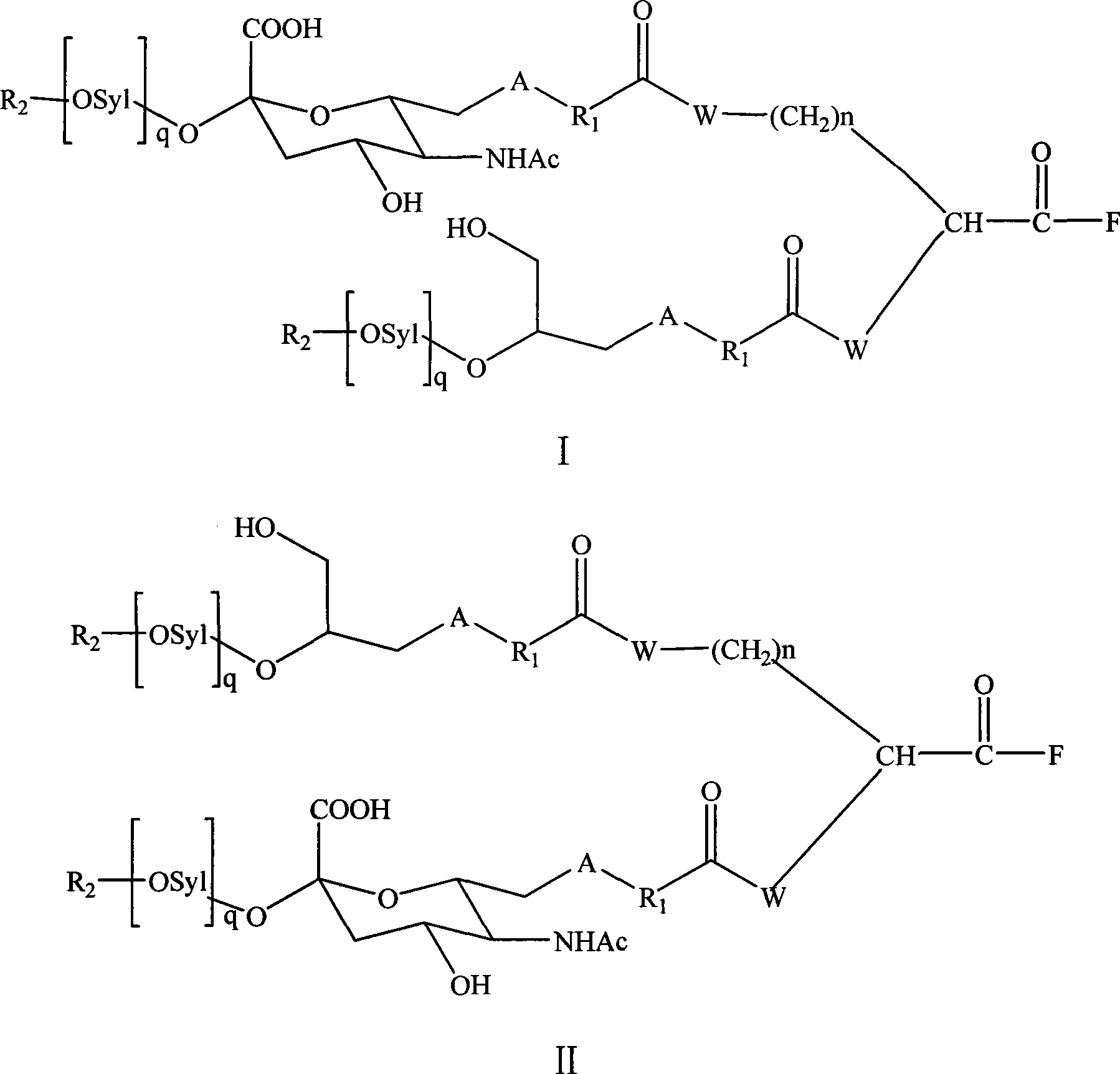Preparation and use of double branching polysialic acid active derivative
A technology of polysialic acid and its derivatives, which is applied in the direction of medical preparations with non-active ingredients, medical preparations containing active ingredients, drug combinations, etc. It can solve the problems of reduced biological activity, difficulty in realizing advantages, and loss of conjugates, etc. Achieve high biological activity, improve selectivity, and high retention
- Summary
- Abstract
- Description
- Claims
- Application Information
AI Technical Summary
Problems solved by technology
Method used
Image
Examples
Embodiment 1
[0046] Example 1 Different double-chain polyacetylneuraminic acid CA 2 -Lys-NHS preparation
[0047] Dissolve lysine (439 mg, 3 mmol) in 20 ml of water with a pH value of 8.0-8.3, and then add the freshly prepared active single-chain polyacetylneuraminic acid CA- DSG (1mmol) (prepared according to CN 101160326 method), while using 0.2mol / L NaOH to maintain the pH value of the system at 8.3. After stirring at room temperature overnight, the reaction was cooled to 0 °C. Now use diethyl ether to extract impurities from water, and then use chloroform to continuously extract three times. After the extract is concentrated, it is added dropwise into anhydrous diethyl ether to obtain a white precipitate. CA-Lys-COOH), the terminal functional group is carboxyl.
[0048] To the above product (0.9 mmol) dissolved in anhydrous dichloromethane (30 mL), triethylamine (TEA) was added until the pH value reached 8. Add reducing end activated derivatized single-chain polysialic acid CA-BS i...
Embodiment 2
[0050] Example 2 The same double-chain polyacetylneuraminic acid CA derived from non-reducing end activation 2 -Lys-NHS preparation
[0051] Lysine (0.2mmol) was dissolved in 40ml of borate buffer with a pH value of 8.0-8.3, and then the newly prepared active single-chain polyacetylneuraminic acid CA-DSG (0.6 mmol) (prepared by CN 101160326 method), while using 0.2mol / Lr NaOH to maintain the pH value of the system at 8.3. After stirring at room temperature overnight, the reaction was cooled to 0 °C. Now use diethyl ether to extract impurities from water, and then use chloroform to continuously extract three times. After the extract is concentrated, it is added dropwise into anhydrous diethyl ether to obtain a white precipitate. CA 2 -Lys-COOH), the terminal functional group is carboxyl.
[0052] At 0°C, the above-mentioned CA is dissolved in 2 -Lys-COOH (0.2mmol) in anhydrous dichloromethane (20mL) was added N-hydroxysuccinimide (0.6mmol) and DCC (0.6mmol), stirred at roo...
Embodiment 3
[0053] Example 3 The same double-chain polyacetylneuraminic acid CA derived from reducing end activation 2 -Lys-NHS preparation
[0054] Change the active single-chain polyacetylneuraminic acid CA-DSG (prepared according to the CN 101160326 method) derived from non-reducing end activation in the above example 2 into an equivalent amount of active single-chain polyacetylneuraminic acid derived from reducing end activation Acid CA-BS 3 That's it.
PUM
 Login to View More
Login to View More Abstract
Description
Claims
Application Information
 Login to View More
Login to View More - R&D
- Intellectual Property
- Life Sciences
- Materials
- Tech Scout
- Unparalleled Data Quality
- Higher Quality Content
- 60% Fewer Hallucinations
Browse by: Latest US Patents, China's latest patents, Technical Efficacy Thesaurus, Application Domain, Technology Topic, Popular Technical Reports.
© 2025 PatSnap. All rights reserved.Legal|Privacy policy|Modern Slavery Act Transparency Statement|Sitemap|About US| Contact US: help@patsnap.com



